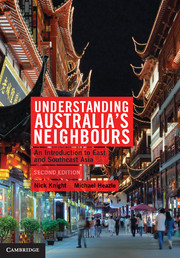Book contents
- Frontmatter
- Contents
- List of Maps
- Acronyms and abbreviations
- Acknowledgments
- Maps
- Introduction
- 1 The idea of ‘Asia’
- 2 Tradition and modernity in East and Southeast Asia
- 3 Tradition and modernity in East and Southeast Asia
- 4 Colonialism in East and Southeast Asia
- 5 Nationalism and revolution in East and Southeast Asia
- 6 Nations and nation-building in East and Southeast Asia
- 7 International politics and East and Southeast Asia
- 8 Economic growth in East and Southeast Asia
- 9 Democracy, human rights and development
- 10 Globalisation and East and Southeast Asia
- 11 China–Japan relations and US power in the twenty-first century
- 12 Australia in Asia, ‘Asia’ in Australia
- Bibliography
- Index
- References
4 - Colonialism in East and Southeast Asia
How important was the impact of the West?
Published online by Cambridge University Press: 05 June 2012
- Frontmatter
- Contents
- List of Maps
- Acronyms and abbreviations
- Acknowledgments
- Maps
- Introduction
- 1 The idea of ‘Asia’
- 2 Tradition and modernity in East and Southeast Asia
- 3 Tradition and modernity in East and Southeast Asia
- 4 Colonialism in East and Southeast Asia
- 5 Nationalism and revolution in East and Southeast Asia
- 6 Nations and nation-building in East and Southeast Asia
- 7 International politics and East and Southeast Asia
- 8 Economic growth in East and Southeast Asia
- 9 Democracy, human rights and development
- 10 Globalisation and East and Southeast Asia
- 11 China–Japan relations and US power in the twenty-first century
- 12 Australia in Asia, ‘Asia’ in Australia
- Bibliography
- Index
- References
Summary
ONE OF THIS BOOK'S major themes is how external factors have affected East and Southeast Asia. In the two previous chapters we looked at the family and religion as evidence of how modernisation, a process that first emerged in Europe, has influenced the traditional societies of this region. While some aspects of the family and religion have changed, others have not. The societies of East and Southeast Asia appear to be a mixture of tradition and modernity. What is the relative importance of each?
Consider the effect of Western (and in particular European) colonialism. Many historians of East and Southeast Asia conclude that it is impossible to understand the region in the present without an understanding of the impact of the West on Asia during the colonial period. While in general terms this conclusion is justified, it leaves open the more specific issue of the extent of the influence of the West on East and Southeast Asia. Was the domination and influence of European colonialism so great that local histories and cultures became insignificant in comparison? Should the history of East and Southeast Asia, from the sixteenth to the mid-twentieth centuries, be understood primarily in terms of Western impact and Asian response? Imperial history claims colonialism was the decisive factor, not the internal histories of the colonies themselves. An alternative view is that colonial control was sporadic and incomplete, and never able to supplant local cultures and societies as the dominant historical force. The societies of East and Southeast Asia had their own histories prior to colonisation, and these stubbornly persisted despite the attempt by European powers to dominate and remake Asian societies in their own (European) image. How else, this perspective asks, can one explain the continuity of indigenous, non-Western, traditions into the post-colonial era, and their subsequent significant political and cultural influence?
- Type
- Chapter
- Information
- Understanding Australia's NeighboursAn Introduction to East and Southeast Asia, pp. 61 - 80Publisher: Cambridge University PressPrint publication year: 2011



